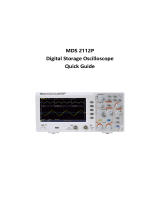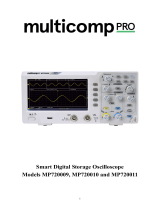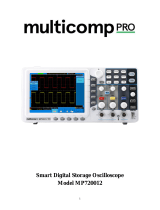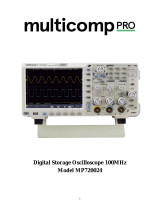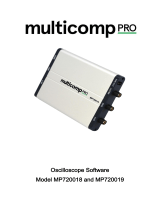Page is loading ...

e-mail: [email protected]
For latest product manuals:
omegamanual.info
Shop online at
omega.com
®
User’s Guide
HOS-MS420
20mhz Oscilloscope
MADE IN CHINA
1

Servicing North America:
U.S.A.: Omega Engineering, Inc., One Omega Drive, P.O. Box 4047
ISO 9001 Certified Stamford, CT 06907-0047 USA
Toll Free: 1-800-826-6342 TEL: (203) 359-1660
FAX: (203) 359-7700 e-mail: [email protected]
Canada: 976 Bergar
Laval (Quebec), H7L 5A1 Canada
Toll-Free: 1-800-826-6342 TEL: (514) 856-6928
FAX: (514) 856-6886 e-mail: [email protected]
For immediate technical or application assistance:
U.S.A. and Canada: Sales Service: 1-800-826-6342/1-800-TC-OMEGA
®
Customer Service: 1-800-622-2378/1-800-622-BEST
®
Engineering Service: 1-800-872-9436/1-800-USA-WHEN
®
Mexico/ En Español: 001 (203) 359-7803 FAX: 001 (203) 359-7807
Latin America [email protected] e-mail: [email protected]
Servicing Europe:
Benelux: Managed by the United Kingdom Office
Toll-Free: 0800 099 3344 TEL: +31 20 347 21 21
FAX: +31 20 643 46 43 e-mail: [email protected]
Czech Republic: Frystatska 184
733 01 Karviná, Czech Republic
Toll-Free: 0800-1-66342 TEL: +420-59-6311899
FAX: +420-59-6311114 e-mail: [email protected]
France: Managed by the United Kingdom Office
Toll-Free: 0800 466 342 TEL: +33 (0) 161 37 29 00
FAX: +33 (0) 130 57 54 27 e-mail: [email protected]
Germany/ Austria: Daimlerstrasse 26
D-75392 Deckenpfronn, Germany
Toll-Free: 0800 6397678 TEL: +49 (0) 7056 9398-0
FAX: +49 (0) 7056 9398-29 e-mail: [email protected]
United Kingdom: OMEGA Engineering Ltd.
ISO 9001 Certified One Omega Drive, River Bend Technology Centre, Northbank
Irlam, Manchester M44 5BD United Kingdom
Toll-Free: 0800-488-488 TEL: +44 (0) 161 777-6611
FAX: +44 (0) 161 777-6622 e-mail: [email protected]
OMEGAnet
®
Online Service Internet e-mail
omega.com info@omega.com
It is the policy of OMEGA Engineering, Inc. to comply with all worldwide safety and EMC/EMI
regulations that apply. OMEGA is constantly pursuing certification of its products to the European New
Approach Directives. OMEGA will add the CE mark to every appropriate device upon certification.
The information contained in this document is believed to be correct, but OMEGA accepts no liability for any
errors it contains, and reserves the right to alter specifications without notice.
WARNING: These products are not designed for use in, and should not be used for, human applications.

2
V5.1‐March2010
INTRODUCTION
Congratulations on your purchase of the Extech Digital Oscilloscope. This
manual is divided into two sections: Section One for the Oscilloscope
functions and Section Two for the MultiMeter functions. This meter is shipped
fully tested and calibrated and, with proper use, will provide years of reliable
service.

3
V5.1‐March2010
TABLE OF CONTENTS
GENERAL INFORMATION
WARRANTY 5
P
RODUCT CONTENTS 6
S
AFETY INFORMATION 7
I
NPUT CONNECTIONS 10
F
RONT PANEL AND CONTROL KEYS OVERVIEW 11
R
ECALL FACTORY DEFAULT SETTINGS 19
PC
DATA TRANSMISSION 63
FAQ. 76
A
PPENDIX A: SPECIFICATIONS 77
A
PPENDIX B: MAINTENANCE AND CLEANING 82
A
PPENDIX C: BATTERY CHARGING AND REPLACEMENT 83
A
PPENDIX D: SETTING THE REAL TIME CLOCK 84
SECTION ONE - OSCILLOSCOPE
BASIC INSTRUCTIONS ON USING THE OSCILLOSCOPE 13
P
OWERING THE OSCILLOSCOPE. 13
M
AIN OSCILLOSCOPE DISPLAY SCREEN 13
M
ENU DESCRIPTION 15
S
ETTING THE TRIGGER POSITION AND TIME BASE 15
O
SCILLOSCOPE INPUT CONNECTIONS 19
M
EASURE UNKNOWN SIGNALS / AUTO SET FEATURE 20
A
UTO ZERO THE HORIZONTAL TRIGGER. 20
A
UTOMATIC RANGING MEASUREMENTS 20
D
ATA HOLD 21
A
VERAGE MODE TO SMOOTH WAVEFORMS 22
P
ERSISTENCE MODE (SUPERIMPOSE WAVEFORMS) 22
P
EAK DETECT (GLITCH CAPTURE) 23
AC
COUPLING MODE 24
R
EVERSE WAVEFORM POLARITY 25
M
ATHEMATICAL FUNCTIONS 26
USB
MASS STORAGE . 27
A
DVANCED OSCILLOSCOPE FUNCTIONS 28
V
ERTICAL SETTINGS FOR CH1 AND CH2 28
C
HANNEL COUPLING 29
O
PEN AND CLOSE MEASUREMENT CHANNELS 30
S
ETTING THE PROBE ATTENUATION 30
I
NVERT A WAVEFORM DISPLAY. 30
M
ATHEMATICAL FUNCTION MENU SETTINGS 31
S
ETTING UP THE TRIGGER SYSTEM 32
T
RIGGER CONTROL 33
A
CQUISITION MODE 40

4
V5.1‐March2010
D
ISPLAY SETTINGS 40
S
TORING WAVEFORMS IN THE METER 42
F
UNCTION SETTINGS MENU 43
A
UTO CALIBRATION. 44
A
UTO RANGE MEASUREMENTS 44
A
UTOSCALE MODE . 45
C
URSOR MEASUREMENTS 49
F
REQUENCY COUNTER (MS460) 52
S
QUARE WAVE OUTPUT. 53
FFT
MODE.(MS420) 54
S
YSTEM STATUS MENU. 61
T
IME BASE MODE . 62
SECTION TWO – MULTIMETER FUNCTIONS 64
CONNECTING THE METER. 65
D
ISPLAY WINDOW. 65
R
ESISTANCE MEASUREMENTS 67
M
EASURING DIODE VOLTAGE 67
C
ONTINUITY TEST. 68
M
EASURING CAPACITANCE 69
M
EASURING DC VOLTAGE 69
M
EASURING AC VOLTAGE 70
M
EASURING DC CURRENT 71
M
EASURING AC CURRENT 72
D
ATA HOLD (FREEZE READINGS) 73
R
ELATIVE MEASUREMENTS 74
A
UTOMATIC / MANUAL RANGE 75
Copyright © 2010 Extech Instruments Corporation (a FLIR company)
All rights reserved including the right of reproduction in whole or in part in any form.

5
V5.1‐March2010
PRODUCT CONTENTS (REFER TO THE FIG. 1 BELOW)
1. MS420 / MS460 Instrument
2. AC Adaptor
3. Oscilloscope Probes (2); Grey in color
4. Multimeter test leads (2); One black, one red
5. USB mass storage connection cable
6. Extension module for low capacitance measurements
7. Probe adjustment tools
8. USB or Serial PC Communication cable
9. User manual
10. CD-ROM Software Program
11. Carrying Case
Figure 1: Supplied Equipment

6
V5.1‐March2010
SAFETY INFORMATION
Please read the user manual before use to ensure safety and precision
SAFETYSYMBOLSANDTERMS
SAFETY SYMBOLS
THESE SYMBOLS MAY APPEAR IN THIS MANUAL OR ON THE INSTRUMENT:
WARNING: “WARNING” IDENTIFIES CONDITIONS & ACTIONS THAT POSE A HAZARD
TO THE USER
Caution: “Caution” identifies conditions and actions that may damage the
product or external equipment
SAFETY TERMS
The following terms may appear on the instrument:
Danger: The term “Danger” is used in this manual to indicate that
immediate personal injury can result
Warning: The term “Warning” is used in this manual to indicate that,
although immediate personal injury is not likely, caution should be
taken
Notice: The term “Notice” is used in this manual to indicate that damage to
the meter or to other equipment can occur
DANGER:
High
Refer to the
Manual
Protective
Conductor
Terminal
Chassis
Ground
Earth
(ground)
Terminal

7
V5.1‐March2010
GENERALSAFETYINFORMATION
Carefully read the following safety information in order to avoid personal injury and
damage to this product or to products connected to it. This product must only be
used in the specified manner to prevent danger and hazard to products and persons.
Warning:
To avoid fire or electrical shock please use the proper power adapter. Use only
the power adapter recommended by the manufacturer.
Warning:
To avoid fire or electrical shock do not connect meter to more than 42V peak
(30Vrms) or on circuits of more than 4800VA:
● Use only the insulated voltage probes, test leads and adapter supplied with
the test tool, or as indicated by Extech as suitable for the Oscilloscope &
Multimeter.
● Before use, inspect voltage probes, test leads and accessories for
mechanical damage. Replace the equipment when it appears damaged.
● Remove all probes, test leads and accessories when not in use.
● Always connect the power adapter first to the AC outlet before connecting
it to the Oscilloscope & Multimeter.
● Do not apply voltages that exceed 400 V from earth ground to any input
when measuring in a CAT II environment.
● Do not apply voltages that exceed 400 V to the isolated inputs when
measuring in a CAT II environment.
● Use caution when using 1:1 test leads since the probe tip voltage will be
directly transmitted to the Oscilloscope & Multimeter.
● Do not use exposed metal BNC or banana plug connectors.
● Do not insert metal objects into the connectors.
● Always use the Oscilloscope & Multimeter in the manner specified.
● Voltage ratings, mentioned in the warnings, are provided as “working
voltage” limits. They represent V ac rms (50-60Hz) for AC sine wave

8
V5.1‐March2010
applications and as V dc for DC applications. Overvoltage Category II refers
to local level applicable for appliances and portable equipment.
Only qualified technical personnel should perform maintenance on these
devices.
Observe the nominal value limits for all terminals: To avoid fire or electric shock,
observe all nominal value limits, markings, and specifications for this product. Before
connecting to this product, carefully read the user’s manual.
Do no operate this instrument without the cover plate secured: If the cover plate
or panel has been removed, do not use this product.
Do not touch bare conductors
Do not use this meter in case of any undetermined failure: When in doubt
consult qualified repair personnel
Do not hinder the meter’s ventilation: Refer to the user manual for detailed
installation instructions and proper setup for adequate ventilation
Do not operate this meter in overly humid environments.
Do not operate this meter in potentially explosive environments.
Keep the meter’s surface clean and dry.
Use of this device in any manner inconsistent with the uses specified in this manual
can possibly compromise the safety protection provided by the meter.

9
V5.1‐March2010
INPUT CONNECTIONS
INPUTCONNECTIONS
See Figure 2 below
Figure 2
Description
1. The power adapter is use to supply AC power and for battery recharging
2. Multimeter test leads
3. Multimeter input jacks (L to R: Current 2A-10A input, mA Current input, COM
ground input, Voltage/Resistance/Capacitance input)
4. Oscilloscope probes
5. Oscilloscope channel inputs
6. Square wave output jack
6

10
V5.1‐March2010
FRONTPANELANDKEYPADOVERVIEW
Figure 3

11
V5.1‐March2010
Description of Meter Front Panel and Keypad (Figure 3)
1. AC adapter Port
2. RS-232C Port
3. USB Port
4. USB Mass Storage Port
5. Power switch
6. F1 – F5 Soft-key options
7. AUTO SET: In the Scope mode, the meter automatically selects the
horizontal/vertical scale and trigger level
8. COPY: Press to store the waveform data into a USB storage device
9. ▲ (Red): Adjust the horizontal scale for Channel 1
10. VOLTS POSITION (Red): Switch between voltage and horizontal scales for
Channel 1
11. ▼ (Red): Adjust the horizontal scale for Channel 1
12. ▲ (Blue): Adjust the horizontal scale for Channel 2
13. VOLTS POSITION (Blue): Switch between the voltage and horizontal scales
for Channel 2
14. ▼ (Blue): Adjust the horizontal scale for Channel 2
15. RUN/STOP: Start/Stop the waveform capture process
16. BACKLIGHT: Turn the display backlight ON and OFF
17. DMM/OSC: Operation mode (switch between oscilloscope and multimeter)
18. MENU ▲: Choose a higher item on a menu list
19. MENU: Show / Hide menu
20. MENU ▼: Choose a lower item on a menu list
21. OPTION: Used in combination with the four (4) yellow arrow keys. This
button is used to set the main time base, trigger horizontal position and
trigger vertical position. Also used to adjust the display multiplier factors and
display vertical position during waveform calculation. Further, it is used to
adjust cursor 1 (V1 or T1) and cursor 2 (V2 or T2) position during cursor
measurements
22. ▲ (yellow): Oscilloscope UP arrow adjustment key
23. ▼ (yellow): Oscilloscope DOWN arrow adjustment key
24. ► (yellow): Oscilloscope FORWARD adjustment key
25. ◄ (yellow): Oscilloscope BACKWARD adjustment key
26. A: Selects DMM Current measurement mode
27. V: Selects DMM Voltage measurement mode
28. R: Selects DMM impedance, diode, continuity, capacitance measurement
mode
29. SET: Toggle AC/DC in the current or voltage multimeter measurement
modes; also switches between resistance, diode and capacitance modes
while in the resistance mode.

12
V5.1‐March2010
BASIC OSCILLOSCOPE FUNCTIONS
ABOUTTHISCHAPTER
This chapter provides introductory Oscilloscope instructions. This introduction does
not cover all of the oscilloscope capabilities but provides basic examples of menu
navigation and operations. Detailed instructions are provided in the Advanced
Oscilloscope functions section.
POWERINGTHEOSCILLOSCOPE
Connect the oscilloscope to an AC power source using the supplied AC adaptor.
If the battery is charged, the oscilloscope may be powered by the supplied and
installed Li-ion battery. The meter will run for up to four (4) hours on a full charge.
Turn the oscilloscope on by pressing the power key.
Upon power up, the instrument performs a ‘self check’. The display will show the
“press any key to continue……” screen.
MAINOSCILLOSCOPEDISPLAYSCREEN
Figure 4: Oscilloscope Display Screen

13
V5.1‐March2010
Description of Oscilloscope Display Screen (Figure 4)
1. Battery power status icon (
, , and )
2. Auto measurement screen No. 1 (“f” for frequency, “T” for cycle, “V” for
average value, “Vp” is the peak-peak value and “Vk” is the root-mean-
square value
3. Auto measurement screen No. 2
4. Horizontal triggering position
5. The difference in time between the horizontal triggering position and the
screen’s centerline (zero when the pointer is in the center of the screen)
6. The trigger modes:
Auto: The oscilloscope is in the automatic mode and displaying the
waveform in the non-trigger mode
Trig’d: The oscilloscope has detected a trigger and is displaying the
information generated after the trigger
Ready: All pre-triggered data has been captured and the oscilloscope is
ready to receive trigger signals
Scan: The oscilloscope records and displays waveform data continuously
Stop: The oscilloscope has stopped collecting waveform data
7. Red and blue trigger pointer shows vertical position of alternate triggers.
The trigger pointer turns green when it reaches an edge trigger or a video
trigger
8. Hide or View the menu using the MENU key;
9. Menu setting options (vary with each function)
10. Trigger Voltage Level
11. Trigger signal source
12. Primary Time Base

14
V5.1‐March2010
13. The coupling mode for CH2; “~” AC, “-” DC, and ground
14. The vertical Voltage units scale for CH2
15. The coupling mode for CH1; “~” AC, “-” DC, and ground
16. Vertical Unit Scale for CH1
17. The blue pointer shows the ground point of the waveform for CH2 (zero
position). If this pointer is not shown, the channel has not been opened.
18. OPTION (options vary with each function)
19. The red pointer shows the ground point of the waveform for CH1 (zero
position). If this pointer is not shown, the channel has not been opened
20. Waveform display area. Red waveform represents CH1, blue represents
CH2

15
V5.1‐March2010
MENUDESCRIPTION
The following explains how to navigate the menus to select a function.
1. Press the MENU key to open the Function Menu. The Menu appears on the right
of the screen with the corresponding options available on the bottom of the
screen. Press MENU again to hide the Function Menu.
2. Use the MENU ▲ or MENU ▼ keys to navigate and select menu functions.
3. Use the soft-keys (F1…F5) to select an available option
Figure 5: Menu
MANUALLYSETTINGTHETRIGGERPOSITIONANDTIMEBASE
Use the OPTION key to set the vertical trigger position, the main time base and
the horizontal trigger position during Edge triggering and Video Triggering or vertical
trigger position for Horizontal time base and vertical trigger position and horizontal
level position during an Alternate trigger.
The following example shows how to use the OPTION key to change a setting.
For triggering in edge and video trigger mode:
1. Press the OPTION key once; the following will appear at the screen’s bottom left:
◄/► – Time Base
▲/▼ – Trig

16
V5.1‐March2010
Figure 6
2. Press ◄ (yellow) or ► (yellow) to adjust the main time base. Press ▲ (yellow)
or▼ (yellow) to adjust the trigger horizontal position.
3.
Press OPTION again and the following will appear:
◄/► – Time
▲/▼– Trig
See Figure 7:
Figure 7
4. Press ◄ (yellow) or ► (yellow) to adjust time base horizontal position, press▲
(yellow) or ▼ (yellow) to adjust trigger position.
5. Use the OPTION key to toggle between the two modes described above.

17
V5.1‐March2010
When triggering in the Alternate trigger mode:
7. Press OPTION and the following will appear:
—Time
—Trig 2
See Figure 8:
Figure 8:
7. Press ◄ (yellow) or ► (yellow) to adjust the time base horizontal position and
press ▲ (yellow) or ▼ (yellow) to adjust the trigger horizontal position for Channel 2.
8. Press OPTION again to display the following:
— Time Base
— Trig 1
See Figure 9:

18
V5.1‐March2010
Figure 9:
9. Press ◄ (yellow) or ► (yellow) to adjust the main time base and press ▲
(yellow) or▼ (yellow) to adjust the trigger horizontal position for Channel 1.
10. Press OPTION again to return to step 6 above.
Glossary of Terms
z Vertical scale factor: The voltage amplitude represented by a division in the
vertical direction of the display area, through the adjustment of which the user can
amplify or attenuate the signal and thus regulate the signal amplitude so that it is
placed in the expected measurement range.
z Vertical zero position: Ground point, through the adjustment of which the user
can regulate the display position of the waveform on the screen.
z Main time base: The time value represented by a division in the horizontal
direction of the display area.
z Trigger horizontal position: The time difference between the actual trigger point
and the screen central line, which will be displayed as 0 at the center point of the
screen.
z Trigger level position: The voltage difference between the actual trigger level
and the zero position of the triggering signal source channel.

19
V5.1‐March2010
RECALLTHEFACTORYDEFAULTSETTINGS
To reset the Oscilloscope to the factory default settings, refer to the following:
1. Press the MENU key; the function menu will appear on the right side of the
screen
2. Press the MENU ▲ or MENU ▼ key to select a FUNCTION; three options will be
visible at the bottom of the screen.
3. Press F1 (Recall Factory) to recall the factory settings.
4. Press F2 to select “Auto calibration”.
If the ambient temperature varies from the
specified operating temperature by more than 5 degrees Celsius, an Auto
Calibration should be performed.
Refer to Figure 10:
Figure 10: Resetting the Oscilloscope
OSCILLOSCOPEINPUTCONNECTIONS
The Oscilloscope has two (2) signal inputs (located on the lower right side) for CH1
and CH2 measurements.
Isolated inputs allow for independent floating measurements between Multimeter and
Scope functions.
/

